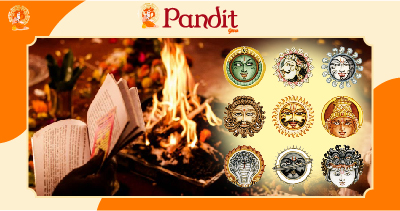Interested: 05 Availablity: In Stock



| Product Id |
| PG812391 |
| Product Price |
| ₹ 3900.00 |
| Availability |
| Available |
Navagraha Havan is a Vedic ritual that involves the worship of the nine celestial bodies or planets, known as the Navagrahas. These nine planets are believed to have a significant influence on an individual's life, and performing a Navagraha Havan is thought to mitigate the adverse effects of planetary positions and enhance positive energies. The ritual is often conducted by individuals seeking protection, prosperity, and overall well-being.
Procedure for Navagraha Havan:
Purification: The ritual begins with the purification of the place where the Havan is to be performed. This involves cleaning the area and creating a sacred space.
Installation of the Navagraha Idols: Images or symbols representing the nine planets are installed in a specific arrangement. Each planet is associated with a specific deity, and these deities are invoked during the Havan.
Invocation of Deities: Mantras and prayers are recited to invoke the blessings of the Navagrahas and seek their divine presence during the Havan.
Offerings: Various offerings, such as grains, ghee, herbs, and other symbolic items, are offered into the sacred fire. Each offering is accompanied by specific mantras dedicated to the respective planet.
Recitation of Navagraha Mantras: The participants recite Navagraha Mantras, which are powerful chants associated with each planet. These mantras are believed to pacify the planetary influences and bring positive energies.
Havan Kund: The offerings are made into the Havan Kund or sacred fire. The fire is considered a purifying element, and the offerings are believed to reach the celestial bodies through the smoke.
Final Prayers: The ritual concludes with final prayers, expressing gratitude to the Navagrahas and seeking their blessings for the well-being and prosperity of the participants.
Chandi Havan:
Chandi Havan, also known as Durga Havan or Chandi Yagya, is a powerful Vedic ritual dedicated to Goddess Chandi or Durga. It is performed to invoke the divine energy of the goddess, who is considered a symbol of strength, courage, and protection. Chandi Havan is often chosen for its ability to remove obstacles, destroy negativity, and bring about positive transformations.
Types of Chandi Havan:
Chandi Homam: This is a general form of Chandi Havan where the worship of Goddess Chandi is performed to seek her blessings for overall well-being and protection.
Navarna Mantra Havan: The Navarna Mantra, dedicated to Goddess Chandi, is chanted during this Havan. It is believed to grant spiritual upliftment and protection.
Saptashati Path Havan: This involves the recitation of the Devi Mahatmya or Durga Saptashati along with the Havan. It is considered particularly potent for dispelling negative forces and promoting positive energy.
Benefits of Chandi Havan:
Protection: Chandi Havan is believed to provide protection from negative forces, black magic, and evil influences.
Courage and Strength: Devotees seek the blessings of Goddess Chandi for courage, strength, and the ability to overcome challenges.
Removal of Obstacles: The ritual is performed to remove obstacles and hurdles in one's life, promoting success and prosperity.
Spiritual Upliftment: Chandi Havan is also seen as a means of spiritual elevation, connecting individuals with the divine energies of the goddess.
Procedure for Chandi Havan:
The procedure for Chandi Havan involves the installation of Goddess Chandi's idol or image, recitation of specific mantras, and the offering of various items into the sacred fire. Devotees often observe a fast and maintain a pure state of mind during the ritual.
In summary, both Navagraha Havan and Chandi Havan are sacred Vedic rituals with distinct purposes. Navagraha Havan is performed to appease the nine celestial bodies for overall well-being, while Chandi Havan is dedicated to Goddess Chandi for protection, strength, and spiritual upliftment. The choice between the two depends on the specific needs and goals of the individual or community performing the ritual.